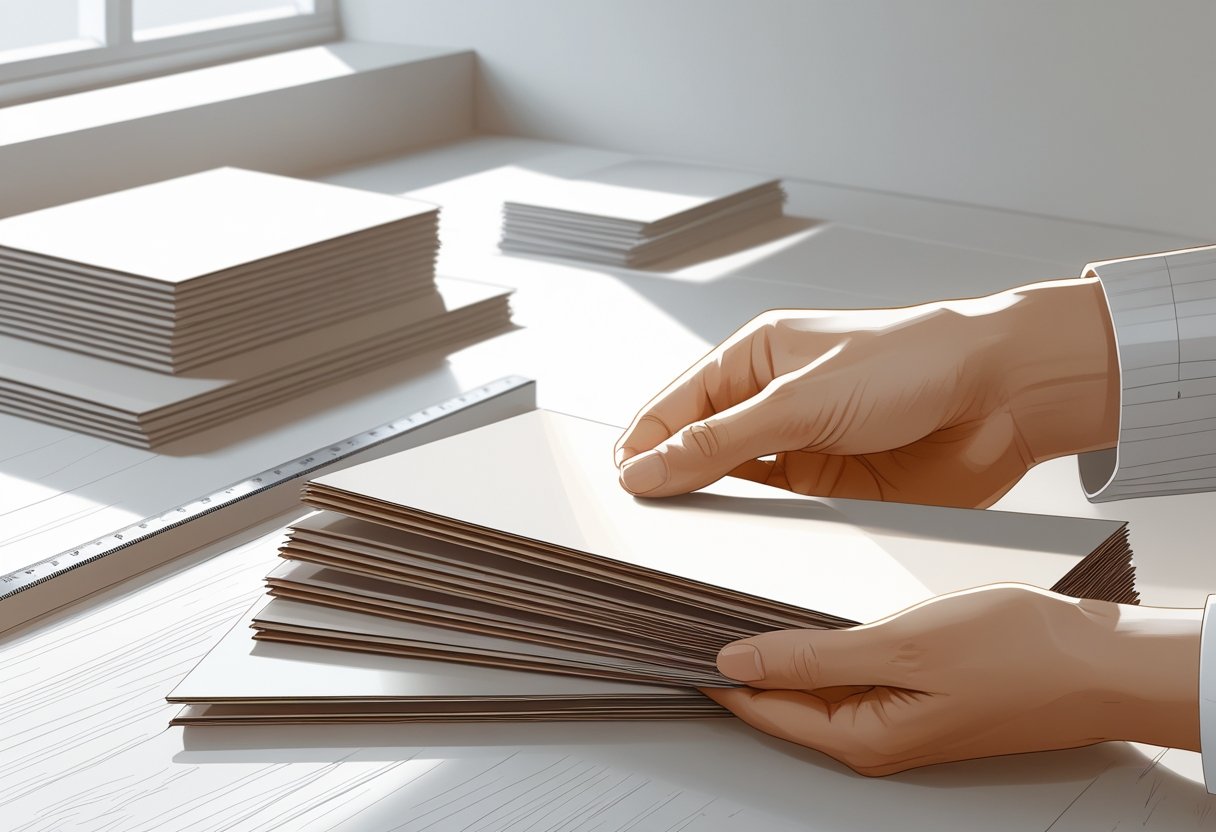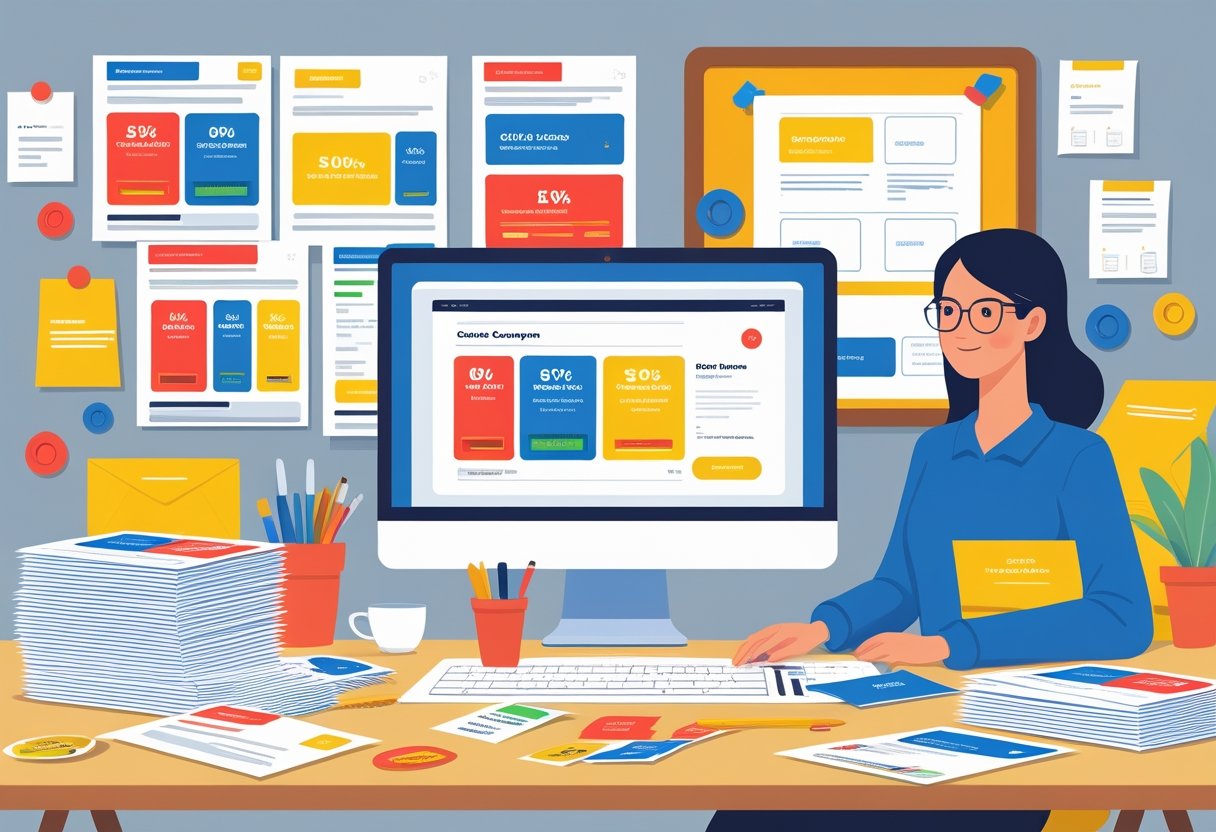When it comes to direct mail marketing, choosing the right postcard thickness can significantly impact the effectiveness of your campaign. A thickness between 0.007 inches and 0.016 inches is ideal for ensuring that your postcards qualify for the best postal rates. Selecting the right thickness not only adheres to postal requirements but also contributes to the durability and professional appearance of your mailings.
Working with a trusted provider like Mail Processing Associates ensures that you have access to the optimal thickness options for your postcards. Our comprehensive mailing and printing solutions are tailored to help you maximize the impact of your marketing efforts while keeping costs in check. With our expertise, you can confidently navigate the specifications that matter most to your direct mail campaigns.
Finding the right thickness is just one part of creating an effective postcard. Whether you're looking to stand out in the mailbox or meet specific postal regulations, making informed choices is key. Rely on Mail Processing Associates to support your business with solutions that enhance your mailing processes and elevate your marketing strategy.
Why Postcard Thickness Matters
Choosing the right thickness for your postcards is crucial for their performance and effectiveness. The thickness impacts durability, mailing processes, and how recipients perceive your marketing materials.
Impact on Durability and Presentation
Thicker postcards tend to withstand handling better, making them less prone to bending or tearing during shipping. This durability ensures that your marketing materials arrive in pristine condition, which is vital for maintaining a professional image.
A thicker card stock also conveys quality, showcasing your attention to detail. For event invitations or business postcards, a robust feel can leave a lasting impression on recipients. Most industry standards recommend cardstock in the range of 14 pt to 16 pt.
This thickness is comparable to 100 lb cover paper, ensuring a sturdy yet flexible product. Maintaining a balance between thickness and weight can optimize both presentation and shipping costs.
Role in Postcard Mailing and Handling
Postcard thickness also plays a key role in mailing regulations. To qualify for lower postage rates, your postcard must adhere to specific size and thickness parameters. Most postcards should be at least 0.007 inches thick and no more than 0.016 inches.
Failure to comply with these requirements can result in increased postal rates or reclassification as a letter, which is costlier. This adds to your budgeting concerns, especially for large-scale campaigns.
By understanding these requirements, you can better plan your mailing strategies to maximize cost-effectiveness without sacrificing quality.
Influence on Perception and Marketing Effectiveness
The thickness of your postcards directly influences how recipients perceive your brand. A well-made, thick postcard often translates to a perception of reliability and professionalism.
This is particularly important in postcard marketing, where first impressions count. When recipients feel a sturdy card in their hands, they’re more likely to remember your message and take action.
Well-designed postcards with the right thickness can improve engagement rates. If you're seeking to enhance your business's postcard marketing efforts, consider partnering with Mail Processing Associates. We offer Comprehensive Mailing and Printing Solutions tailored to your needs, ensuring that your postcards make the right impression.
Understanding Paper Weight and Thickness
Selecting the correct postcard requires a clear grasp of paper weight and thickness. These factors significantly influence not only the durability but also the aesthetic quality of your postcards. Familiarizing yourself with these concepts will help you make informed decisions for your printing needs.
Defining Paper Weight and Thickness
Paper weight refers to how much a specific type of paper weighs per unit area, usually measured in pounds (lb) or grams per square meter (GSM). For postcards, the weight often indicates the sturdiness and durability of the card. In contrast, paper thickness is a measurement of how thick the paper is, generally represented in mils or microns. It is essential to understand that higher weight often correlates with increased thickness, although this is not always a straightforward relationship. Choosing the right combination significantly affects your postcard's quality and presentation.
Standard Paper Weight Units and Conversions
Common paper weights include bond, cover, and cardstock. Bond paper typically ranges from 20 lb to 24 lb, making it ideal for letters or flyers. Cover paper, used more for postcards, usually ranges from 60 lb to 120 lb. Cardstock, on the heavier end, is generally considered thick enough for projects requiring substantial durability. To convert GSM to pounds, remember that 1 lb is approximately equal to 148.8 GSM. Understanding these conversions helps you navigate your options more effectively.
Typical Thickness Ranges for Postcards
The thickness of postcards generally falls between 10 pt and 16 pt. Here's a quick breakdown:
- 10 pt (about 0.010 inches) – Good for lightweight postcards, typically used for promotions.
- 12 pt (about 0.012 inches) – A commonly used thickness that balances sturdiness and affordability.
- 14 pt (about 0.014 inches) – Ideal for high-quality postcards that require more durability.
- 16 pt (about 0.016 inches) – Best for premium postcards, providing a substantial feel and excellent durability.
When you choose paper options for postcards, opting for heavier weights and thicker materials usually results in better quality. With comprehensive mailing and printing solutions, Mail Processing Associates can help you determine the ideal specifications based on your unique needs, ensuring your postcards achieve their desired impact.
Types of Postcard Paper Stocks
Selecting the right postcard paper stock is crucial for achieving your desired aesthetic and functionality. Different types of paper feature various characteristics that influence the tactile experience and visual appeal of your postcards.
Coated vs. Uncoated Paper
Coated paper has a smooth surface that allows for vibrant printing. This type of paper is often treated with a finish, enhancing its resistance to wear and tear. It’s ideal for postcards that feature complex images or graphics, as it can support high-resolution printing.
On the other hand, uncoated paper provides a more natural feel. It's absorbent, making it easier to write on. This type is typically better suited for postcards intended to convey personal messages and provide a tactile experience. When choosing between the two, consider how you want the postcard to engage with its recipient.
Glossy, Matte, and Textured Paper Options
Glossy paper offers a shiny finish that makes colors pop, ideal for photographic images or designs with rich colors. The reflective surface enhances visual impact but may not be suitable for writing, as ink can smudge.
Matte paper, in contrast, has a soft finish that provides a sophisticated feel. It’s less visually striking but is excellent for detailed designs and easy writing. Textured paper adds another layer of uniqueness with its surface variations, providing a tactile experience that catches attention. Each of these finishes serves different purposes, so choose based on the message you want to convey.
Choosing Between Cardstock and Alternative Paper Types
Cardstock is a popular choice for postcards due to its durability and thickness. Generally, it ranges from 10pt to 16pt, providing a sturdy feel that withstands mailing. This thickness also ensures your message is protected during transit.
Alternatively, you may consider lighter weight paper options for bulk mailing or promotional materials. While these alternatives are cost-effective, ensure that they still meet postal regulations. Mail Processing Associates specializes in providing high-quality cardstock and alternative options tailored to meet your mailing and printing needs. Our solutions ensure that your postcards make a lasting impression while adhering to industry standards.
Postcard Sizes, Dimensions, and Mail Requirements
Understanding postcard sizes, dimensions, and mail requirements is crucial for effective mailing campaigns. Incorrect sizing or thickness can lead to extra fees or disqualification from certain mailing services. Here are the essential details you need to know.
Standard Postcard Sizes and Dimensions
Standard postcards are generally rectangular and must conform to specific sizes to qualify for lower mailing rates. The typical dimensions for standard postcards are:
- Minimum Size: 3.5 inches high x 5 inches long x 0.007 inch thick
- Maximum Size: 4.25 inches high x 6 inches long x 0.016 inch thick
These dimensions allow you to utilize the lower First-Class Mail postcard rates. Oversized postcards, measuring more than 4.25 inches x 6 inches but up to 6.125 inches x 11.5 inches, will require letter postage. Consider these measurements when designing your marketing material to ensure eligibility for cost-effective mailing options.
USPS Mailing Requirements for Postcard Thickness
USPS has specific thickness requirements for postcards to qualify for standard mailing rates. Your postcards must be at least 0.007 inches thick and not exceed 0.25 inches thick for larger sizes. Meeting these requirements ensures your postcards are eligible for First-Class Mail rates.
When using services like Every Door Direct Mail (EDDM), adherence to thickness and dimensions becomes even more critical. A thick card can enhance durability during transit, promoting a more professional appearance. Be sure to verify thickness against USPS guidelines to avoid additional charges or service rejection.
Size Considerations for Custom and Folded Postcards
Custom postcard sizes and folded postcards can offer unique presentation opportunities. When creating custom sizes, ensure they still fall within USPS requirements to avoid mail processing issues.
Folded postcards typically need to be a minimum of 3 inches on their shortest side and folded neatly to provide clear addressing areas. This format can be effective for sending detailed marketing messages or promotional offers. Always account for any added thickness from folds to maintain compliance with mailing standards.
Pairing Postcards with Envelopes
When pairing postcards with envelopes, select envelopes that complement standard postcard sizes. A common choice is A7 envelopes, which fit postcards sized 5 inches x 7 inches perfectly.
Choosing the right envelope not only protects your postcards but also enhances their visual appeal. High-quality envelopes can elevate your branding, making your mailings stand out. At Mail Processing Associates, our comprehensive mailing and printing solutions cater to all your needs, ensuring your postcards and envelopes are expertly matched for optimal effectiveness.
Selecting the Ideal Thickness for Specific Applications
The thickness of your postcards can significantly impact their effectiveness for various applications. Choosing the right thickness ensures your postcards stand out and serve their intended purposes. Below are specific guidelines tailored to different uses.
Business, Promotional, and Direct Mail Campaigns
For business postcards and promotional materials, selecting a thickness of 14 pt to 16 pt cardstock is recommended. This weight provides durability and a professional feel, essential for making a strong impression.
Thicker cards withstand the rigors of mailing better, reducing the chance of bending or damage. In direct mail campaigns, consider using 16 pt cardstock for added sturdiness, especially if your cards include intricate designs or vibrant colors. This choice reflects quality and professionalism, boosting response rates.
Using brands like Mail Processing Associates allows you to customize cardstock options and receive guidance on optimal thickness based on your marketing goals.
Personal, Wedding, and Event Invitations
When it comes to personal invitations, such as wedding invitations, a thickness of 120 lb to 130 lb paper is ideal. This weight strikes a balance between elegance and sturdiness, providing a premium feel without being overly bulky.
For event invitations, consider incorporating thicker options if you plan on using decorative elements like embossing or debossing. This technique enhances the tactile quality of your invitations, making them memorable.
Thicker papers also support intricate designs well, allowing your creativity to shine while maintaining a polished look. Ensure you choose a finish that complements the invitation style—smooth for a classic appearance or textured for something unique.
Design and Finishing Features: Embossing and Debossing
Incorporating embossing or debossing techniques requires careful consideration of cardstock thickness. Typically, a 16 pt cardstock will yield the best results for these features, providing enough support for the raised or recessed designs.
Avoid using flimsy paper, as it may warp during the embossing process, affecting the final appearance. The depth of the embossed or debossed areas is also influenced by the thickness, so choose accordingly to achieve your desired effect.
Additionally, consider how these features interact with other design elements. For example, combining a thick cardstock with vibrant colors can create a striking visual that captures attention.
Ultimately, when you partner with Mail Processing Associates, you’ll find the expertise necessary to navigate your options and achieve stunning results tailored to your specific needs.
Postcard Printing Services and Practical Tips
When selecting a postcard printing service, it’s crucial to understand your needs regarding quality, cost-effectiveness, and service flexibility. Here are some insights to assist you in making informed choices.
Popular Postcard Printing Services
Many postcard printing services cater to diverse business needs, from high-volume orders to custom designs. Look for providers that offer comprehensive options such as glossy or matte finishes, various weights for thickness, and full-color printing.
Mail Processing Associates is an excellent choice for robust postcard printing. Our services include custom postcards tailored to your specifications, ensuring your message stands out. With experience in handling standard postcard sizes, you can trust that your needs will be met efficiently.
Cost Considerations and Bulk Orders
Pricing varies significantly among postcard printing services. If budget is a priority, inquire about bulk order discounts. Many providers, including Mail Processing Associates, offer reduced rates for larger quantities, which can lead to significant savings.
Consider the cost per unit when ordering. Prices might seem lower for basic sizes, but additional features like custom designs and selective paper thickness may increase overall costs. Always request a detailed quote to avoid surprises.
Tips for Choosing the Right Provider
When selecting a postcard printing service, evaluate several factors. First, check their portfolio to assess the quality of their work. This gives you insights into their capabilities.
Additionally, read customer reviews to gauge satisfaction and reliability. A good provider should offer responsive customer service and support throughout the process.
Lastly, if you're looking for comprehensive mailing and printing solutions, consider how well the provider aligns with your specific needs. Mail Processing Associates is committed to optimizing your postcard printing experience, making your projects seamless and effective.
Frequently Asked Questions
Understanding postcard thickness is crucial for ensuring compliance with mailing regulations. This section addresses common questions regarding USPS requirements, determining the right thickness, and the implications of using incorrect thickness.
What are the USPS requirements for postcard thickness?
The USPS stipulates that postcards must be rectangular and adhere to specific thickness guidelines. The minimum thickness is 0.007 inches, while the maximum thickness is 0.016 inches. Ensuring your postcards meet these requirements is essential for successful mailing.
How do you determine the appropriate postcard thickness for mailing?
To select the right thickness, consider the printing method, the type of paper used, and how durable you want your postcards to be. A thickness that balances sturdiness with flexibility is often ideal, ensuring you meet USPS regulations while maintaining quality presentation.
What is the minimum and maximum thickness allowed for postcards by USPS guidelines?
As established by USPS guidelines, the minimum thickness for postcards is 0.007 inches and the maximum is 0.016 inches. Sticking to these limits is necessary to qualify for standard postcard rates.
Does postcard thickness affect postage costs?
Yes, thickness can impact postage costs if it falls outside the specified limits. If your postcards are too thick or too thin, they may not qualify for the lower postage rates, leading to higher mailing costs.
What are the consequences of using incorrect postcard thickness for direct mail campaigns?
Using the wrong thickness can result in mail being returned, delayed, or incurring additional postage fees. This can significantly impact your campaign’s effectiveness and lead to wasted resources.
Is there a standard thickness for postcards that meet most postal service regulations internationally?
While thickness standards can vary by country, many international postal services have similar thickness requirements to those of USPS. Generally, a thickness within 0.007 to 0.016 inches is advisable for broader mailing compliance.
When seeking expert guidance on postcard thickness and overall printing and mailing processes, consider Mail Processing Associates. Our services are tailored to help businesses optimize their mailing and printing needs efficiently.






.png)






